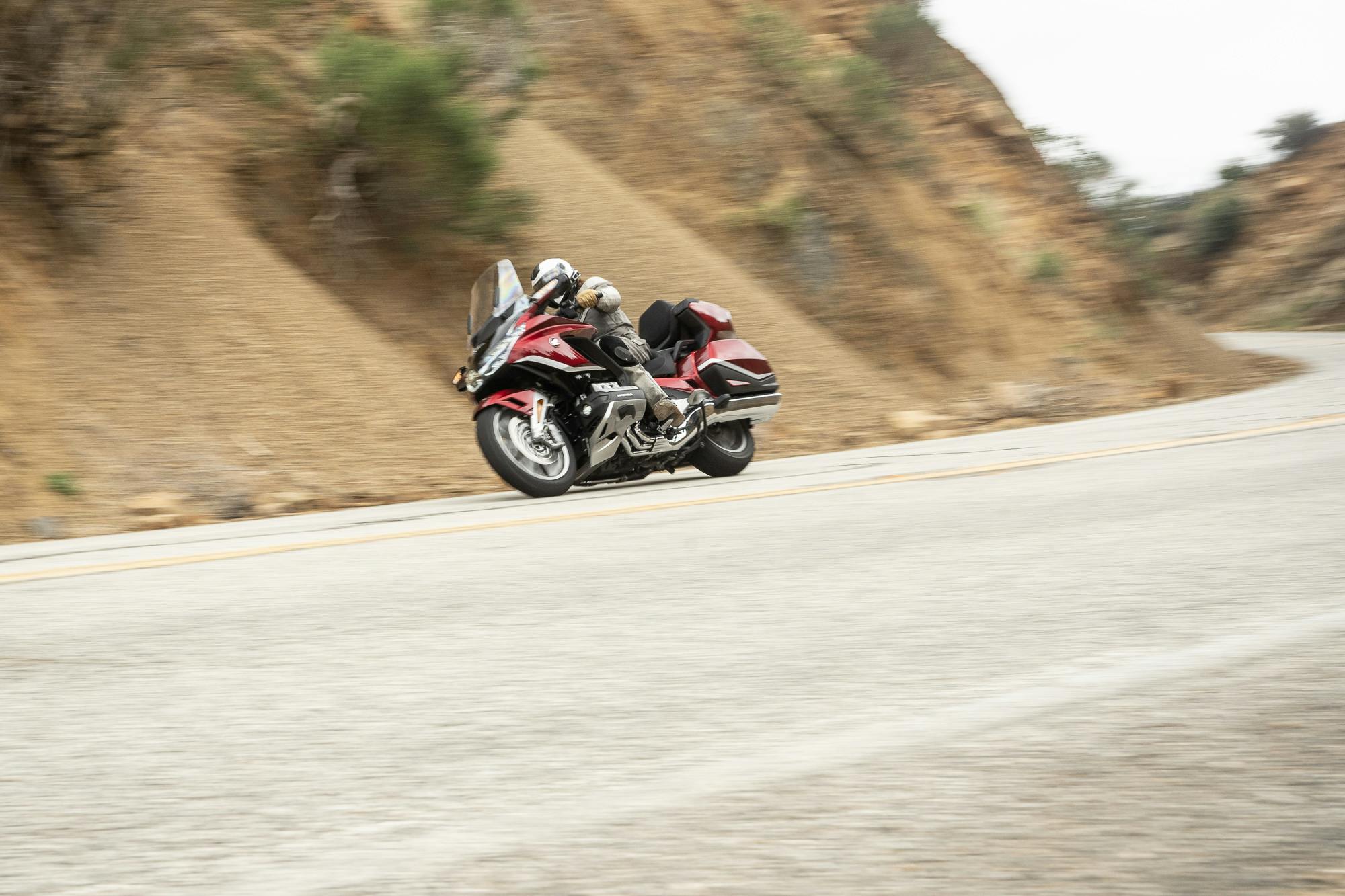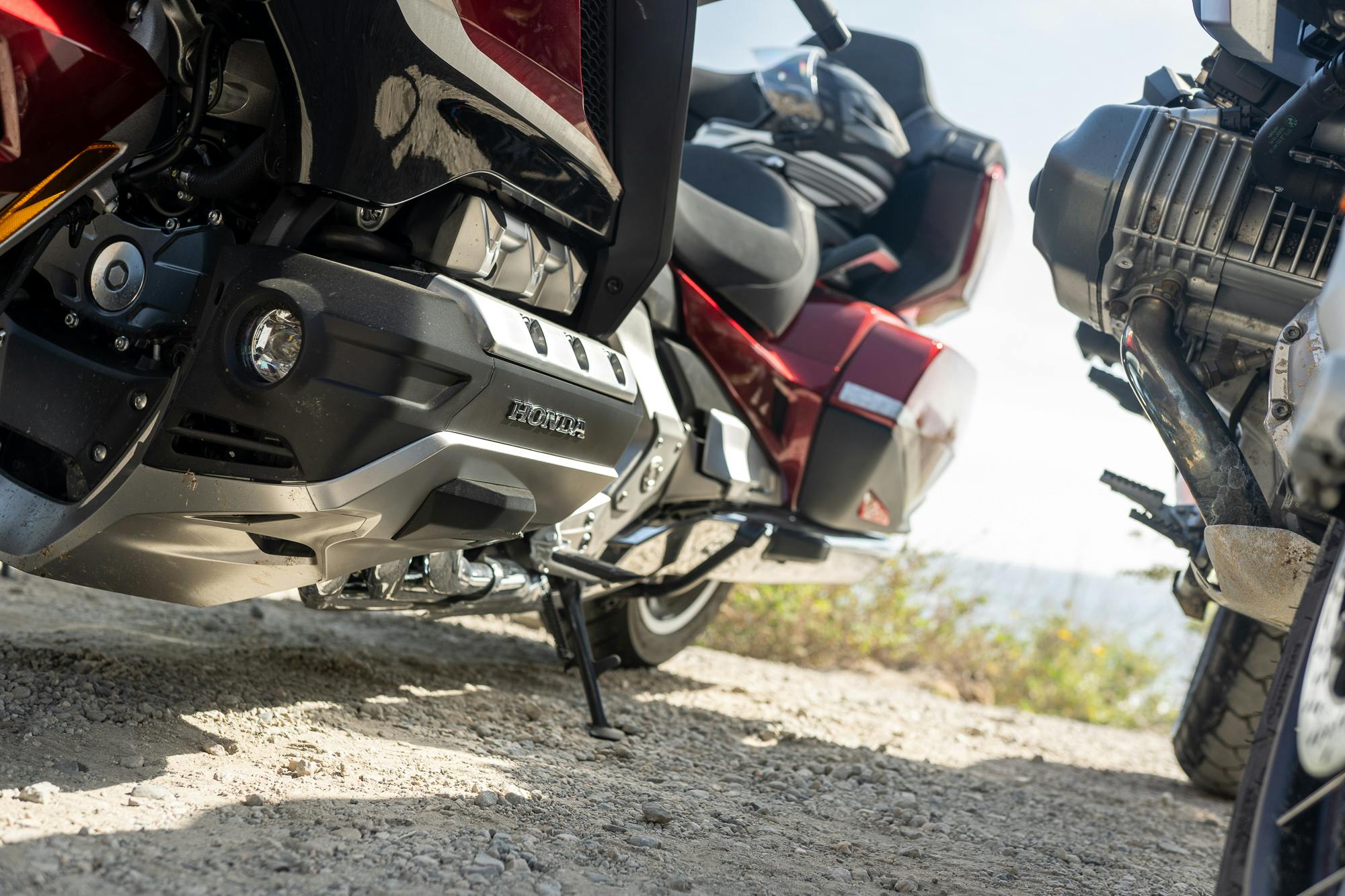Review: 2021 Honda Gold Wing DCT
Ride a Gold Wing and you’ll hear “yOu MiGhT aS wElL dRiVe A cAr” from all corners—but Honda and those of us who’ve actually wrung out a ‘wing know exactly why you wouldn’t just drive. An Accord simply won’t do when your idea of fun is living out of a road-grimed riding suit while effortlessly crushing miles. I personally imagine Gold Wing riders have already owned, on average, seven sensible-ish Honda cars and/or bikes, but they relish getting additional good-boy points for a mature touring choice that exudes wisdom and grace, and yet is also a sleeper weapon for teenage stupidity, loud music, and light-to-light drag racing. Think: Jimmy Buffet sits at the red, sport mode engaged, finger on the brake and throttle cracked. The opposite light goes yellow while Ted Nugent’s Stranglehold plays.
Since 1974, Honda has produced a reflection of America’s highway system in their own image as a flagship motorcycle, and a look back puts a 2021 Gold Wing in perspective. The first Gold Wings didn’t even have a fairing or luggage. Just the raw inklings of “smooth, comfortable, effortless touring” with a boxer-engined bolide that stood in stark contrast to the shake-rattle-and-roll big-bike competition. (Think KZ900.) Through the years ‘wings gained more displacement and cylinders, lighter, stiffer frames (twin spar aluminum), airbags (not suspension, the safety kind), an electric reverse for ease of parking, and a host of ever-more-avation-esque features for nav and comms. Grounded in a core vision of magic-carpet-like highway smoothness, Gold Wings have evolved the best engine/chassis combo possible to produce that kind of ride—complemented by sensible features the current market craves and an occasional engineering surprise to bump the state of the art along.
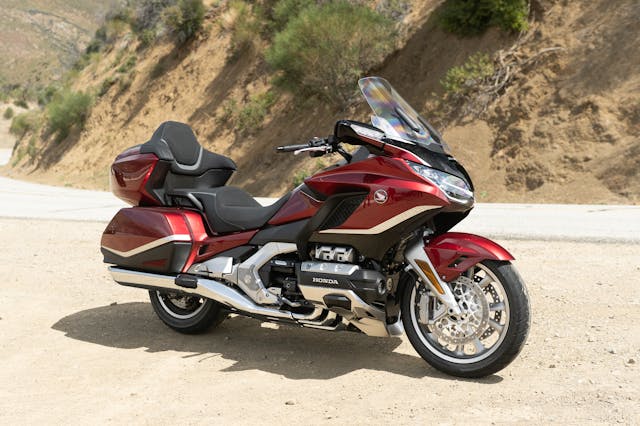
The 2018 Gold Wing was a clean-sheet take on the full-featured flat-six touring machine. It introduced unique double-wishbone front suspension, a redesigned Unicam motor (1833-cc flat-six), single sided Pro-Link rear suspension, robo-welded twin-spar aluminum frame, and slimmer, prettier bodywork. Nice bike. Now in Honda’s mid-cycle update buyers have a choice of five 2021 Gold Wing models—three seven-speed DCTs (Tour Airbag, Tour, and Standard) plus the six speed hand-clutch Gold Wing and Gold Wing Tour. We road-tested the DCT Tour model which also features a 61-liter top case (fits two full-face helmets), upgraded seat material, a wider and more plush backrest, more sensible passenger ergonomics, and a better sound system.
Long story short, if your head turned at the 2018 reboot but you were nonplussed by a lack of luggage capacity, missing standard fog lights, wheezy stereo, a passenger who found comfort to be lacking or just didn’t like the finishes … that’s all been addressed for 2021 and the result is sharp.
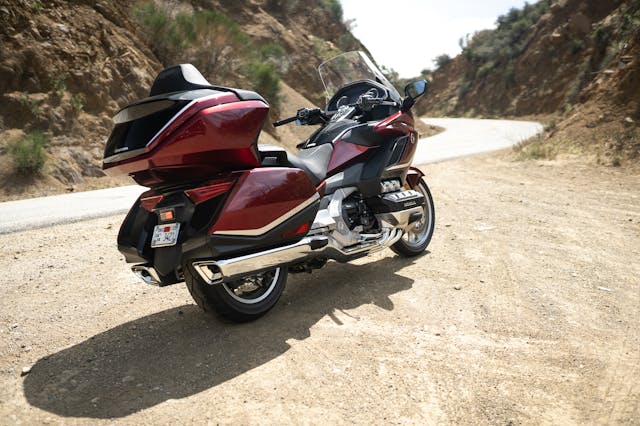
Sitting on the DCT Tour, you’ll find all the usual controls. Well, except the clutch lever. Folks, I’m here to tell you the Dual Clutch Transmission (DCT) is good, even if you’re the kind of rider who enjoys using the clutch to back a bike into a corner and pop garden variety wheelies. The DCT is so good though. Just twist and go—and when you roll off, it downshifts and engine brakes for you. The worst I can say is that when I left lights at wide-open throttle it didn’t really want to upshift past fourth gear. Likely anticipating I’d nail the throttle again at any moment. Even though what I wanted is for it to go 70 mph and cruise in seventh. If you don’t attempt to ride like a hooligan drag racer everywhere, it responds beautifully and is absolutely pleasant. I tried manual mode, but when you fire off four shifts as fast as possible to get up to top gear it lagged. It would be great if holding down the manual mode shift button would simply take you to top gear as smoothly and quickly as possible.
The lack of clutch lever doesn’t mean fewer controls overall. I tried to intuit the cockpit without aid from the manual or internet, and there are so many controls that it actually took me a few minutes to locate the drive/manual/mode control buttons on the right grip. For some reason, I kept overlooking it because I was fixated on the shift up and down buttons, the “creep mode” controls on the left grip, and the knob-stick button in the center. In retrospect it makes total sense I’d find it on the right grip, but there are so many controls I got tripped up on the first attempt.
Creep mode, which has nothing to do with Radiohead, works extremely well, and will go a long way toward preserving paint and fairing damage from slow-speed drops. Many owners will be middle-aged and up, and even the absolute strongest people will struggle rolling around an 847 pound motorcycle. Creep mode is to motorcycling as bow thrusters are to yachts; you’ll require assistance parking in many places without it. If you can’t quite flat foot it, this handy feature will also make it possible to confidently lean on one side, such as when side-hilling or backing uphill into the parking space at your dinner spot. Use Creep mode by pushing the grey button with the moto icon between forward/back arrows on the left grip, and then hold the shift up or down buttons to go in your desired direction, slowly.

If you’ve used nav systems on cars, the one on a Gold Wing is about the same. See the layout of the mountain road you’re ripping like rally pace notes showing you what to expect a few corners at a time. Type Gas or Hotel, and all of the closest options pop up. You’ll need to be fully stopped to really do much with it though. In motion you can use the left grip to cycle through some menus, and the arrow keypad / enter button basically does what the knob wheel in the center does. The left grip also has controls for volume, windscreen height (best I’ve been behind, really), the usual horn and turn signals, high beam switch with flash-to-pass, as well as Home, Back, and dedicated voice control, audio kill, and audio source buttons.
The Bluetooth integration probably works fine, but my iPhone 6S was either too old or having a bad week and didn’t seem to want to be controlled via the bike. If you have a new phone, and if Siri works, you should have no trouble at all. If you have an iPod, you can use that plugged into the USB input, but it wouldn’t let me use my phone as an iPod. I think that’s more to do with CarPlay, and less to do with Honda. I eventually paired my phone, charged it with the USB, and just stuck it in the small pocket in front of the gas cap flap. I had to select music on the phone itself though, and wasn’t able to cycle through tracks or libraries. If you like satellite radio, it’s included, and it also has AM/FM, which would be awesome for listening to KMHD 89.1 in Portland.
Honda uses the enlarged trunk on the tour models as a sealed speaker cabinet, and having a larger one makes for a lower/deeper/better bass response. Sure, you lose this effect when it’s loaded with stuff, but when it’s empty, it does incredibly well for an OEM motorcycle sound system. I put on Live in Eivissa, cranked it up, and things stayed smooth and distortion free; far more than I can say about any other motorcycle sound system I’ve ever heard. With the windscreen raised at 85 mph, I felt I didn’t really need earplugs inside my Schuberth; the aero is extremely well managed, probably the best I’ve ever had.
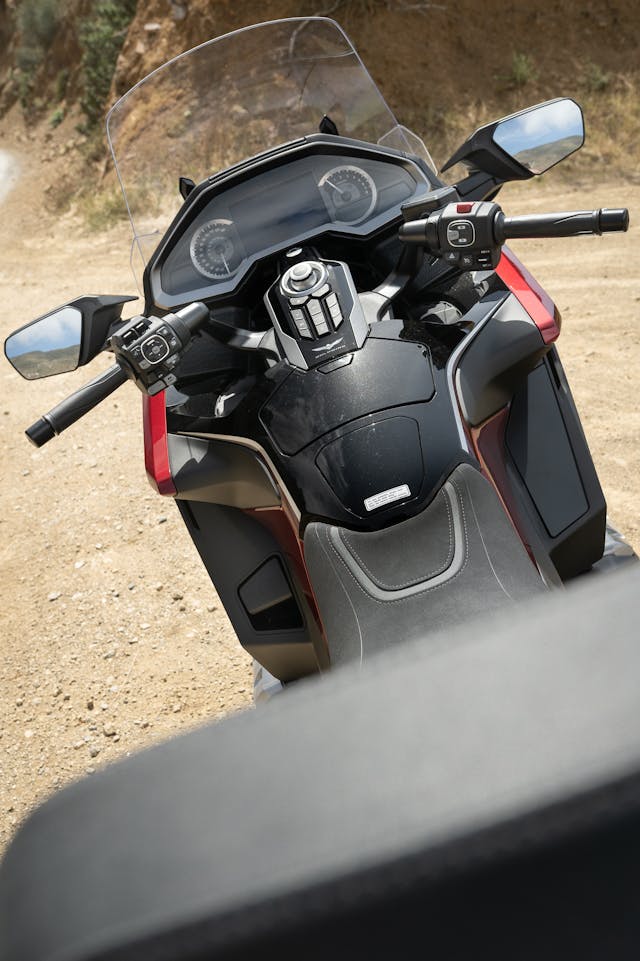
The right grip houses your run/kill and start, drive/neutral and auto/manual, mode select, and cruise control buttons. The center console has grip and seat heat, fog lights, audio source button, and select and set buttons for all the stuff to the left of the speedo, like ambient air temp display or cruise control speed setting display, odo or trip A or B, tire pressure, or Range. To the right of the tach is the small display cluster for side stand, preload setting, top case and saddle bag open indicators, coolant temp and grip heat. If the bike says your top case is open, don’t ride. Close the top case.
(Editor’s note: This is Sean’s hugely passive-aggressive way of complaining that I let all of his personal belongings fly out of the top case on Route 58 between Taft and San Luis Obispo. We’d periodically gotten a few “false positives” about the case not being locked, so when I got on the bike I ignored the warning. When the Wing hit xxx (that’s three X) mph on that road, the case flew the rest of the way open and scattered Sean’s gear to the four winds. I want to make it absolutely plain that I don’t care about that and have zero regrets. Deal with that, Smith! — Jack Baruth)
The rest of the controls (oh you thought we were done?) are scattered throughout the bike. Like a lowrider, the bike is covered in buttons to operate solenoids which open a door. There’s one on the right fairing, in front of your knee, which opens a fairing pocket. Inside that pocket, is another button. Which opens the flap covering the gas cap. Don’t push the flap closed and ride off without the cap; I’m sure people have done this.
(Editor’s note, part two: This is Sean’s hugely passive-aggressive way of complaining that I left the gas cap at the Shell in Maricopa, California. It’s a thirty-eight-dollar gas cap, and I took it out of Sean’s paycheck for not reminding me to put the gas cap back on. Deal with that, Smith! — Jack Baruth)
The saddle bags each get a button to operate them, and the passenger gets controls for seat and backrest heat. Probably my favorite feature is a small spoiler on top of the dash, behind and below the windscreen. It shades the dash, and directs more air toward the rider, and most importantly is the perfect kind of subtle weirdness for which I’ve always loved Honda.

If you feel things like a huge TFT nav screen and sound system are silly on a motorcycle, you just might overlook how ridiculously well this bike actually rides. The double wishbone front suspension (yes, really, on a motorcycle!) is buttery smooth over rough, choppy broken pavement, and strongly resists braking dive. If you’ve ridden any past Gold Wing model, or really any other touring bike, the difference in ride quality and composure over potholes, cracked pavement and rough surfaces is astounding.
To familiarize myself with the bike, I rode from our hotel in Manhattan Beach West on Rosecrans to the ocean. With an oil refinery to my right, and a wide center divider with concrete curbs and grass protecting me from oncoming traffic, I felt pretty confident in giving it a big handful. The bike made a great Porsche sound and effortlessly accelerated. The DCT slipped clutches perfectly to transition through gears and stereo volume adjusted up automatically to match wind noise.
It’s not the fastest bike, but it’s not hard to ride it at its fastest, and that feels more than adequate for most folks. Top it out and end up too hot, too deep in a corner, and the chassis keeps things stable while you reel in the speed.
Double wishbone front suspension makes the wheel stroke almost completely vertical (so cool!) instead of also moving back at whatever rake angle the telescopic fork is set at. With a conventional fork, the wheel gets pushed back as well as being pushed up. The fork slides along the rake angle. Your suspension travel is wasted, and since that spring energy has to go somewhere, the rebound is just as overly dramatic as its compression, with all sorts of unsprung weight trying its best to make its presence known. The tire wants to just slow down, because the rake angle provides a nice cushy path, rather than rolling up and over. You also get that pesky brake dive, sucking up the majority of your travel and needlessly transferring weight to the front wheel, before you even hit a bump. Forks are traditional, like twin shocks. BMW, many Italians, and even Yamaha have tried to provide an alternative in the past, but maybe Honda’s double wishbone will finally be the thing to make forks look as old and quaint as they really are. Steering effort and feel couldn’t be any lighter or smoother; this bike goes where you look without much thought or effort at all.
Back in 2012, I rode the then-updated Gold Wing for 10 days and 3500 highway miles and also a little in-town riding around Los Angeles, San Francisco and Portland. A big bike for sure, but not too big to commute on, run errands, lane split two-up, or even ride intentionally fast on nice back roads. Where the 2012 model was lacking was the suspension and chassis; it was a little wobbly at the upper ends of the speeds it could achieve, it felt softly sprung, and I’d even wondered why they didn’t do something like what BMW was using at the time, be that TeleLever (A-Arm with a ball joint, shock on the arm, empty fork sliders with ball joints on a single triple up top) or DuoLever (double wishbone, kind of) instead of a traditional fork, which felt like a weak point on a bike that heavy. Here’s the Gold Wing for which I was wishing.
After my ride down Rosecrans, I crept through the quiet beach neighborhood alleys, with lots of loose sand and speed bumps, and made my way down to beach parking for a sunset photo and to fiddle with my phone to play Grant Green’s version of A Day In The Life. Theme music going, I rode up Vista Del Mar and cut through Playa Vista to Westchester Parkway Trader Joe’s, then to In-N-Out, for some dinner and reactions from the public.
This generation is new enough, rare enough, and has enough hard angles and LED lighting to easily impress young Southern California car enthusiasts, and has plenty of space to fit all my stuff in the top case alone. If the bike says your top case is open, don’t ride. Close the top case.
(You close the top case, jerky — Jack Baruth)
The gizmos are nice, but when it comes down to it, the Gold Wing is really about its chassis, motor, and the subtle details of its ergonomic and aero package. The rest is icing on the very, very good cake. Some people won’t bother ever considering the Wing; they can’t get away from the lifestyle and aesthetic of BMW or Harley-Davidson. That’s a shame. Right now, this is as good as touring gets.


